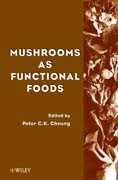
Mushrooms as Functional Foods provides up-to-date information on the chemistry and biology, cultivation, nutritional and medicinal value, and use of mushrooms in the modern functional foods industry. It covers physiology and geneticsand highlights applications for functional food, such as sclerotia, and medicinal uses. It discusses the classification, identification, and commercial collection of truffles, morels, and newly cultivated species and covers regulatory issues. An insert has color photographs of various types of mushrooms. This is the definitive reference for food scientists, pharmaceutical scientists working with mushrooms, mycologists, students, and others. INDICE: Chapter 1. An Overview of Mushroom Cultivation and Utilization as Functional Foods. 1.1 Introduction. 1.2 What Are Mushrooms? 1.2.1 Definition of a Mushroom. 1.2.2 Ecological Classification of Mushrooms. 1.2.3 Identification of Mushrooms. 1.3 The Concept of Mushroom Biology and Applied Mushroom Biology. 1.3.1 Mushroom Biology. 1.3.2 Applied Mushroom Biology: Practical Applications of Mushroom Biology. 1.3.3 Impact of Applied Mushroom Biology. 1.3.3.1 Nongreen Revolution. 1.3.3.2 Mushroom Bioremediation. 1.4 Mushroom Cultivation.1.4.1 Major Phases of Mushroom Cultivation. 1.4.2 Cultivation of Several Selected Mushrooms. 1.4.2.1 Cultivation of Agaricus. 1.4.2.2 Cultivation of Lentinula edodes. 1.4.2.3 Cultivation of Pleurotus sajor-caju. 1.4.2.4 Cultivation of Volvariella. 1.4.2.5 Cultivation of Agaricus brasiliensis. 1.4.2.6 Cultivation of Ganoderma lucidum. 1.4.3 Utilization of Mushroom Germplasm. 1.5 World Mushroom Production. 1.6 Mushroom Biotechnology. 1.6.1 Nutritional and MedicinalValue of Mushrooms. 1.6.2 Nutriceuticals and Dietary Supplements. 1.7 Development of World Mushroom Industry Movements. 1.7.1 The International Movement for Edible Mushrooms. 1.7.2 The International Movement for Medicinal Mushrooms. 1.7.3 The International Movement for Wild Mushrooms. 1.8 Concluding Remarks. References. Chapter 2. Molecular Analysis and Genomic Studies of the Shiitake Mushroom Lentinula edodes. 2.1 Introduction. 2.2 Isolation of Genes. 2.2.1 Growth. 2.2.1.1 Substrate Utilizing Genes. 2.2.2 Development. 2.2.2.1 Mating-type Genes. 2.2.2.2 Genes Differentially Expressed in Dikaryotic Mycelium. 2.2.2.3 Genes for Initial Fruiting Bodies/Primordium Formation. 2.2.2.4 Genes for the Formation of Mature Fruiting Bodies. 2.2.2.4.1 Stipe Elongation. 2.2.2.4.2 Gill Development and Basidiospore Formation. 2.2.3 Physiological Processes in L. edodes. 2.2.3.1 Signal Transduction. 2.2.3.2 Energy Production. 2.2.3.3 Structural Proteins in Development. 2.3 Molecular Genetics. 2.3.1 Generation of Markers. 2.3.2 Typing/Fingerprinting. 2.3.3 Genetic Mapping. 2.4 Functional Genomic Approaches for Gene Expression Analysis. 2.4.1 Differential Display ? RAP-PCR. 2.4.2 cDNA-Representation Difference Analysis (cDNA-RDA). 2.4.3 Serial Analysis of Gene Expression (SAGE) and LongSAGE. 2.4.3.1 SAGE Gene Expression Profiles: Mycelium to Primordium. 2.4.3.2 SAGE Gene Expression Profiles of Fruiting Bodies: Maturation to Sporulation. 2.4.4 cDNA Microarray. 2.4.5 Expressed Sequence Tag (EST). 2.4.6 Yeast Two-Hybrid System. 2.4.7 Sequencing-by-synthesisApproach (454 Life Science). 2.5 Transcriptional Regulation. 2.5.1 Transcriptional Factors. 2.5.2 Promoter Analysis. 2.6 Transformation. 2.6.1 Transformation Method. 2.6.1.1 Polyethylene Glycol (PEG)-mediated Transformation. 2.6.1.2 Restriction Enzyme Mediated Integration (REMI). 2.6.1.3 Others. 2.6.1.3.1 Electroporation. 2.6.1.3.2 Particle Bombardment. 2.6.2 L. edodes Genes Used in Transformation. 2.7 Process Analysis. 2.7.1 Post-harvest Studies. 2.7.2 Stress Responses. 2.7.2.1 Studies of Temperature Stress in Mushrooms. 2.7.2.2 Studies of Molecular Chaperones in Fungi. 2.7.2.2.1 Role of Molecular Chaperones. 2.7.3Lignocellulose Degradation. 2.7.4 Meiosis. 2.8 Conclusion. References. Chapter 3. Nutritional Value and Health Benefits of Mushrooms. 3.1 Introduction. 3.2Wild and Cultivated Edible Mushrooms. 3.3 Production of Cultivated Mushrooms.3.4 Nutritional Composition. 3.4.1 Conventional Edible Mushrooms. 3.4.1.1 Moisture. 3.4.1.2 Proteins and amino acids. 3.4.1.3 Fats. 3.4.1.4 Ash and minerals. 3.4.1.5 Vitamins. 3.4.1.6 Dietary fiber. 3.4.1.7 Carbohydrates. 3.4.1.8 Energy. 3.4.1.9 Other components. 3.5 Newly Cultivated/Nonconventional Mushrooms.3.6 Nutritional Evaluation. 3.6.1 General Aspects. 3.6.2 Biological Methods for Nutritional Evaluation. 3.6.3 Mushroom Protein Quality. 3.7 Health Benefitsof Edible Mushrooms. 3.7.1 General Aspects. 3.7.2 Antioxidants in Mushrooms. 3.7.2.1 Bioactive components and their antioxidative activities. 3.7.2.2 Characterization of mushroom phenolic antioxidants. 3.7.2.3 Biosynthesis of phenolic compounds from mushrooms or fungi. 3.7.3 Hypocholesterolemic Effect of Mushrooms. 3.7.4 Hypoglycemic Effect of Mushrooms. 3.8 Conclusion. References. Chapter 4. Sclerotia: An Emerging Functional Food Derived from Mushrooms. 4.1 Introduction. 4.2 Concepts of Mushroom sclerotia. 4.3 Ontogeny of Sclerotia. 4.3.1. General Aspects. 4.3.2 Physiological Aspects. 4.3.2.1 Translocation. 4.3.2.2Exudation. 4.4 Structure of Sclerotia. 4.4.1 Rind. 4.4.2 Cortex. 4.4.3 Medulla. 4.5 Cultivation of Mushroom Sclerotia. 4.5.1 Sclerotia of Pleutrous tuber-regium (Fries) Singer. 4.5.2 Sclerotia of Polyporus rhinocerus Cooke. 4.5.3 Sclerotia of Wolfiporia cocos (Schw.) Ryv. Et Gilbn (Poria cocos [Schw.] Wolf). 4.6 Biochemical, Nutritional, and Technological Characteristics of Mushroom Sclerotia. 4.6.1 Biochemical Components of Mushroom Sclerotia. 4.6.1.1 Cell Walls. 4.6.1.2 Extracellulam Matrix. 4.6.1.3 Cytoplasmic Reserves. 4.6.1.3.1 Glycogen. 4.6.1.3.2 Polyphosphates. 4.6.1.3.3 Proteins. 4.6.1.3.4 Lipids. 4.6.2 Nutritional Evaluation of Mushroom Sclerotia. 4.6.2.1 Proximate Composition. 4.6.2.2 Sclerotial Dietary Fiber. 4.6.3 Physico-chemical and Functional Properties of Mushroom Sclerotial DF. 4.7 Biopharmacological Values of Mushroom Sclerotiaof P. tuber-regium, P. rhinoceros, and W. cocos. 4.7.1 In Vitro Mineral Binding Capacity. 4.7.2 In Vitro Fermentability. 4.7.3 In Vivo Ca and Mg Absorption. 4.7.4 Antitumor and Immunomodulatory Activities. 4.8 Conclusion. References.Chapter 5. Antitumor and Immunomodulatory Activities of. Mushroom Polysaccharides. 5.1 Introduction. 5.2 Antitumor Polysaccharides from Mushrooms (Higher Fungi). 5.3 Mechanisms of Antitumor Action of Mushroom Polysaccharides. 5.3.1 Anti-Proliferation of Cancer Cells and Induction of Apoptosis. 5.3.2 Immunomodulation. 5.3.2.1 Effects of Mushroom Polysaccharides on Macrophages and Spleen Cells. 5.3.2.2 Effects of Mushroom Polysaccharides on Natural Killer Cells. 5.3.2.3 Effects of Mushroom Polysaccharides on Dendritic Cells. 5.3.2.4 Effects of Mushroom Polysaccharides on Hematopoietic Stem Cells. 5.3.3 Antimetastasis.5.3.4 Antiangiogenesis. 5.4 Structure and Antitumor Activity Relationship of Polysaccharides. 5.4.1 The Effect of Molecular Mass. 5.4.2 The Impact of Branching Configuration. 5.4.3 The Relationship of Antitumor Activity and Conformation. 5.4.4 Improvement of Antitumor Activity by Chemical Modifications. 5.5 Conclusions. References. Chapter 6. Regulatory Issues of Mushrooms as FunctionalFoods and Dietary Supplements: Safety and Efficacy. Abbreviations. 6.1 Introduction. 6.2 Legal and Regulatory Issues of Introducing and Controlling DietarySupplements from Medicinal Mushrooms in Different Countries. 6.2.1 World Health Organization Guidelines. 6.2.2 Codex Alimentarius. 6.2.3 The United States.6.2.4 The European Union. 6.2.5 Canada. 6.2.6 Australia and New Zealand. 6.2.7 Japan. 6.2.8 Israel. 6.3 Safety and Diversity of Dietary Supplement Types from Culinary-Medicinal Mushrooms. 6.4 Submerged Culturing as the Best Techniquefor Obtaining Consistent and Safe Mushroom Products. 6.5 Experiences of SevenCountries in Consolidating Their Food Safety System. 6.6 Summary. References.
- ISBN: 978-0-470-05406-2
- Editorial: John Wiley & Sons
- Encuadernacion: Cartoné
- Páginas: 264
- Fecha Publicación: 05/09/2008
- Nº Volúmenes: 1
- Idioma: Inglés
